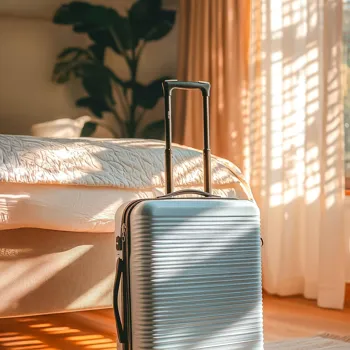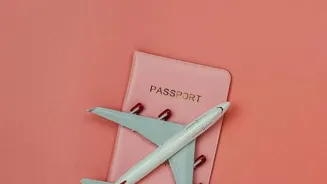10 Essential Travel Tips for First-Time Flyers: A Complete Guide for Indian Passengers. Your go-to resource for a stress-free journey!
Taking your first flight can be exciting, but also a bit nerve-wracking.
Don't worry, we’ve got you covered! This guide provides ten essential tips to ensure a smooth and stress-free travel experience for first-time flyers in India.

From booking your tickets to navigating the airport and in-flight etiquette, we’ll walk you through everything you need to know. So, buckle up and prepare for take-off!
Plan and Book Smart:
Planning your trip well in advance is crucial, especially when flying for the first time. Start by researching your destination, considering the weather, local customs, and any specific requirements for Indian citizens.

Once you have a basic plan, begin comparing flight prices on various websites and airlines. Being flexible with your travel dates can often lead to significant savings. Look for deals during off-peak seasons or consider flying on weekdays, as prices tend to be lower.
When booking, pay close attention to the baggage allowance, as exceeding the limit can incur hefty fees. Read the fine print regarding cancellation and changes policies.
Finally, make sure to double-check all your details, including your name (as it appears on your ID), flight dates, and timings, before confirming your booking. Selecting your seat in advance, if possible, can also enhance your comfort, especially on longer flights.
Remember to book from trusted sources to avoid any issues later. These steps can save you money.
Documents Checklist: Your Travel Bible:
Before you even think about packing your bags, ensure you have all the necessary documents in order. This is perhaps the most important step in ensuring a smooth and hassle-free journey. Carry a valid government-issued photo ID, such as your Aadhaar card, PAN card, or passport.
A physical copy of your flight ticket (e-ticket printout) is essential, although many airlines now accept digital copies on your smartphone. Keep copies of your visa (if required), hotel booking confirmations, and any other relevant travel documents readily accessible.
It's also wise to make digital copies of these documents and store them securely in the cloud or on a USB drive. Sharing the digital copies with a trusted family member or friend back home can serve as a backup in case of loss or theft.
Also, keep your emergency contact information easily accessible (both physical and digital copies). Having all your documents organized and readily available will save you time and stress at the airport. This includes being prepared at security check.
Packing Like a Pro: Luggage Essentials:
Packing efficiently can significantly reduce your stress levels at the airport and throughout your trip. Start by checking the airline's baggage allowance for both checked baggage and cabin baggage. Make a list of essential items and stick to it, avoiding unnecessary overpacking.

Prioritize versatile clothing items that can be mixed and matched to create different outfits. Pack essential toiletries in travel-sized containers to comply with airport security regulations.
Keep important medications, valuables, and essential documents in your carry-on bag, along with a change of clothes in case of any unforeseen delays with your checked baggage.
Ensure that all liquids in your carry-on bag are in containers of 100ml or less and packed in a transparent, resealable plastic bag. Weigh your bags before heading to the airport to ensure they are within the allowed limits, avoiding any surprise charges.
Invest in a good quality suitcase with sturdy wheels for easy maneuverability. This will save you from extra fees and lots more.
Arriving at the Airport: Give Yourself Time:
One of the biggest mistakes first-time flyers make is arriving at the airport too late. Indian airports can be crowded, and security procedures can take time, especially during peak travel seasons.
Aim to arrive at least 2–3 hours before your scheduled departure time for domestic flights, and even earlier for international flights. This will give you ample time to check in, drop off your baggage, go through security, and find your boarding gate without feeling rushed or stressed.
Check your flight status online before leaving for the airport to confirm there are no delays. Familiarize yourself with the airport layout beforehand, either through the airport's website or app, to help you navigate efficiently.
Keep your boarding pass and ID readily accessible, as you will need to present them multiple times. Giving yourself enough time at the airport is a simple, yet crucial step in ensuring a smooth travel experience. Be mindful.
Navigating Security Like a Pro:
Airport security can seem daunting, but it’s a necessary part of air travel. To expedite the process, be prepared to remove electronic devices such as laptops and tablets from your bag and place them in a separate tray.
Remove any metal objects, such as belts, jewelry, and watches, and place them in the tray as well. Ensure that all liquids in your carry-on bag are in containers of 100ml or less and packed in a transparent, resealable plastic bag.
Follow the instructions of the security personnel carefully and cooperate with them to ensure a smooth and efficient screening process. If you have any medical conditions that require special consideration, inform the security officer beforehand.
Avoid making jokes or inappropriate comments to security staff, as this can lead to delays or further scrutiny. Remember that the security measures are in place to ensure the safety and security of all passengers, so be patient and understanding. Being alert is important.
Boarding and In-Flight Etiquette:
Once you've located your boarding gate, listen for announcements regarding boarding. Boarding usually begins 30–45 minutes before the scheduled departure time. When boarding, present your boarding pass to the gate agent and follow their instructions to find your seat.

Be mindful of other passengers while stowing your carry-on luggage in the overhead compartment. Avoid blocking the aisle while you are settling in. Once the aircraft has taken off, follow the instructions of the flight attendants and adhere to safety regulations.
Keep your seatbelt fastened when seated, even if the seatbelt sign is turned off, as unexpected turbulence can occur. Be considerate of your fellow passengers by keeping your voice down, avoiding excessive reclining of your seat, and using headphones when watching videos or listening to music.
If you need assistance, don't hesitate to ask the flight attendants. Being a respectful and considerate passenger contributes to a pleasant and comfortable flight for everyone. Keep this in mind.
Dealing with Turbulence:
Turbulence is a normal part of flying and is rarely dangerous. When turbulence occurs, remain calm and follow these steps: fasten your seatbelt immediately, and ensure that your carry-on items are securely stowed. Follow the instructions of the flight attendants.
Stay seated until the turbulence subsides and the seatbelt sign is turned off. Most of the modern flights are designed for turbulence. Avoid panicking, as this can exacerbate the situation. Turbulence usually lasts only a few minutes. If you are feeling anxious or uncomfortable, take deep breaths.
Understanding the nature of turbulence can help you stay calm and relaxed during such episodes. If you have an anxiety disorder, consult your doctor beforehand about ways to manage your anxiety during flights. This will enable you in your safety.
Staying Comfortable Onboard:
Long flights can be tiring, so it's essential to take steps to stay comfortable. Wear loose and comfortable clothing, and avoid wearing tight or restrictive garments. Drink plenty of water throughout the flight to stay hydrated, as the air inside the cabin can be very dry.
Avoid excessive consumption of caffeine or alcohol, as they can dehydrate you and disrupt your sleep. Take short walks in the aisle to stretch your legs and improve circulation. Use a travel pillow to support your neck and make it easier to sleep. Bring a book, magazine, or downloaded movies.
Consider using noise-canceling headphones to block out the noise and create a more peaceful environment. Following these tips will help you minimize discomfort and arrive at your destination feeling refreshed and ready to go. This is very important to remember.
Food and Hydration:
Staying hydrated and nourished is crucial, especially on long flights. While most airlines provide complimentary meals and beverages, it's a good idea to bring your own snacks and drinks. Pack healthy snacks.

Bring an empty water bottle and fill it up after passing through security to avoid buying expensive bottled water at the airport. Be mindful of any dietary restrictions or allergies. If you have specific meal requirements, consider pre-ordering a special meal when booking your flight.
Avoid overeating. Eating balanced food is recommended. It is always a good measure to do this.
Arrival and Beyond:
Congratulations, you've landed! Once the plane has come to a complete stop and the seatbelt sign is turned off, gather your belongings and wait for the okay to deplane. There's no need to rush, as everyone will be disembarking in an organized manner.
Follow the signs to baggage claim and collect your checked baggage. Check the baggage claim tags to ensure you are taking the correct bags. If your baggage is missing or damaged, report it to the airline's baggage claim office immediately. Follow signs if you have a connecting flight.
Be prepared for customs and immigration procedures if you are arriving on an international flight. Once you have cleared all formalities, you are ready to begin your adventure! Plan your onward transportation from the airport, whether it's a taxi, bus, or pre-booked car rental. Welcome.










